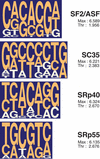ESEfinder: A web resource to identify exonic splicing enhancers
- PMID: 12824367
- PMCID: PMC169022
- DOI: 10.1093/nar/gkg616
ESEfinder: A web resource to identify exonic splicing enhancers
Abstract
Point mutations frequently cause genetic diseases by disrupting the correct pattern of pre-mRNA splicing. The effect of a point mutation within a coding sequence is traditionally attributed to the deduced change in the corresponding amino acid. However, some point mutations can have much more severe effects on the structure of the encoded protein, for example when they inactivate an exonic splicing enhancer (ESE), thereby resulting in exon skipping. ESEs also appear to be especially important in exons that normally undergo alternative splicing. Different classes of ESE consensus motifs have been described, but they are not always easily identified. ESEfinder (http://exon.cshl.edu/ESE/) is a web-based resource that facilitates rapid analysis of exon sequences to identify putative ESEs responsive to the human SR proteins SF2/ASF, SC35, SRp40 and SRp55, and to predict whether exonic mutations disrupt such elements.
Figures


References
-
- Burge C.B., Tuschl,T. and Sharp,P.A. (1999) Splicing of precursors to messenger RNAs by the spliceosome. In Gesteland,R.F., Cech,T.R. and Atkins,J.F. (eds) The RNA World II, Cold Spring Harbor Laboratory Press, Cold Spring Harbor, NY, pp. 525–560.
-
- Cartegni L., Chew,S.L. and Krainer,A.R. (2002) Listening to silence and understanding nonsense: exonic mutations that affect splicing. Nature Rev. Genet., 3, 285–298. - PubMed
-
- Maniatis T. and Tasic,B. (2002) Alternative pre-mRNA splicing and proteome expansion in metazoans. Nature, 418, 236–243. - PubMed
Publication types
MeSH terms
Substances
Grants and funding
LinkOut - more resources
Full Text Sources
Other Literature Sources
Molecular Biology Databases
Research Materials

